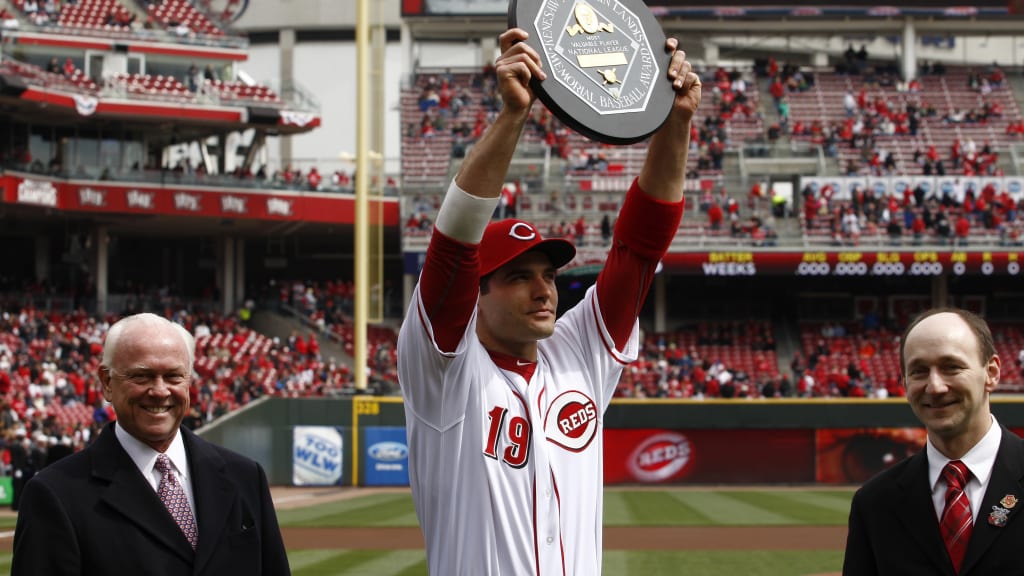
No one loves a good debate quite like baseball fans, and with that in mind, we asked each of our beat reporters to rank the top five players by position in the history of their franchise, based on their career while playing for that club. These rankings are for fun and debate purposes only … if you don’t agree with the order, participate in the Twitter poll to vote for your favorite at this position.
Here is Mark Sheldon’s ranking of the top five first basemen in Reds history. Next week: Second basemen.
• Reds all-time players, by position: Catchers
(One note: Pete Rose will be ranked among third basemen for this series.)
1) Joey Votto, 2007-23
Key fact: Votto had nine seasons with an on-base percentage over .400
Votto was one of the best hitters in baseball during his generation, and he should go down as one of the best all-time Reds while being deserving of a retired No. 19 hanging at Great American Ball Park. In 2010, his 37 home runs, .324 batting average and league-leading 1.024 OPS helped earn him the National League Most Valuable Player Award. Votto nearly won a second MVP (with almost identical numbers) in '17 after he hit 36 homers with a .320 average and league-leading 1.032 OPS.
“I think he’s represented the city unbelievably,” said former Reds scouting director Casey McKeon, who pursued and signed Votto after the 2002 Draft. “He’ll end up in the Reds Hall of Fame. I’m tickled to death for what Joey has done and for what he means to the organization and the leadership there.”
For his 17-year career, the left-handed-hitting Votto batted .294 with 356 home runs and a .920 OPS over 2,056 career games while earning six NL All-Star nods. At the time of his retirement, he was second on the franchise all-time lists in homers, doubles (459), on-base percentage (.409) and OPS, first in walks (1,365), third in runs (1,171) and RBIs (1,144), fourth in hits (2,135) and fifth in games.
Votto may lack the usual age-old benchmarks that often mean entry to Cooperstown. But in an era when advanced analytics have been embraced, his résumé will be worthy of consideration for the Hall of Fame.
2) Tony Perez, 1964-76, 1984-86
Key fact: Elected to the Baseball Hall of Fame in 2000
Revered as a pioneering player from Cuba and affectionately known as the “Big Dog,” Perez was often considered the glue of the Big Red Machine era and played in four World Series for the team. His two-run homer in Game 7 was one of three he hit during the 1975 World Series win against Boston. Much of his prime years and four All-Star seasons were spent as Cincinnati’s third baseman, but he went to three more All-Star Games while playing first base for the Reds.
“With men in scoring position and the game on the line, Tony’s the last guy an opponent wanted to see,” Pirates great Willie Stargell once said of Perez.
Of the 379 homers Perez slugged over his 24-year career, he hit 287 of them for the Reds -- just three ahead of Votto. He ranks fifth on the club’s all-time list in games (1,948) and hits (1,934) and second in RBIs (1,192). Perez was traded to Montreal after the Reds won the 1976 World Series, which marked the beginning of the end of the Big Red Machine. He returned in '84 to finish his career and went to be a coach and manager of the club, which retired his No. 24 in 2000 -- the year he was enshrined in Cooperstown.
3) Ted Kluszewski, 1947-57
Key fact: His No. 18 jersey was retired by the Reds in 1998
Dubbed “Big Klu” because of his large stature and hulking biceps -- often exposed by his sleeveless Reds jersey -- Kluszewski hit 251 home runs during his 11 seasons in Cincinnati. That included leading the Majors with 49 homers and 141 RBIs in 1954.
A four-time All-Star from 1953-56, Kluszewski led the NL in fielding for five consecutive seasons and batted .302/.357/.512 while with the Reds. He was inducted into the club’s Hall of Fame in 1962.
4) Frank McCormick, 1934-45
Key fact: Was an inaugural inductee into the Reds Hall of Fame in 1958
The 1940 NL MVP Award winner, McCormick batted .309/.367/.482 with 19 homers, 127 RBIs and a league-leading 44 doubles that season to lead the Reds to their first World Series title since 1919. A nine-time All-Star for Cincinnati, he led the league in hits for three-straight seasons in 1938-40. He also helped the Reds reach the '39 World Series that ended in a four-game sweep to the Yankees.
Beginning in 1938, McCormick played 652 consecutive games and for a time was the game’s active leader in that category. A .301/.350/.437 hitter while with the Reds, he was also hard to strike out. In ’38, McCormick struck out 17 times in 671 plate appearances (2.5%) and 16 times in 688 plate appearances (2.3%) in ’39.
5) Lee May, 1965-71
Key fact: Batted .389 with two homers and eight RBIs in the 1970 World Series
An early member of the Big Red Machine, May helped lead the club ahead of its dynasty and played in the ’70 World Series that Baltimore won in five games. During an era that favored pitchers, May was known as “The Big Bopper” and slugged 34 or more homers in three-straight seasons from 1969-71 – including a career-best 39 while driving in 98 runs in ’71.
A two-time All-Star for Cincinnati in 1969 and ’71, May ironically helped the team most by no longer playing for it. After the ’71 season, he was dealt to the Astros as part of an eight-player trade that brought the Reds future Hall of Famer Joe Morgan, Cesar Geronimo and Jack Billingham and launched the greatest era in the franchise’s history.
Honorable mentions
Dan Driessen (1973-84) led the NL in fielding three times and helped the club win the 1975 and ’76 World Series … Hal Morris (1990-97, ’99, ‘00) batted .305/.362/.444 in 10 seasons for the Reds and was part of the 1990 World Series championship team. … Sean Casey (1998-2005) was a three-time All-Star who batted .305 in eight seasons and had a career-best .332 average and .938 OPS in ’99.
